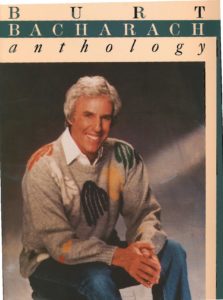Remembering Burt Bacharach (1928-2023)

Best Sheet Music download from our Library.
Contents List Download:

Please, subscribe to our Library.
If you are already a subscriber, please, check our NEW SCORES’ page every month for new sheet music. THANK YOU!
Contents List Download:
Burt Bacharach
Burt Freeman Bacharach (May 12, 1928 – February 8, 2023) was an American composer, songwriter, record producer, and pianist who is widely regarded as one of the most important and influential figures of 20th-century popular music.
Starting in the 1950s, he composed hundreds of pop songs, many in collaboration with lyricist Hal David. Bacharach’s music is characterized by unusual chord progressions and time signature changes, influenced by his background in jazz, and uncommon selections of instruments for small orchestras. He arranged, conducted, and produced much of his recorded output.
More than 1,000 different artists have recorded Bacharach’s songs. From 1961 to 1972, most of Bacharach and David’s hits were written specifically for and performed by Dionne Warwick, but earlier associations (from 1957 to 1963) saw the composing duo work with Marty Robbins, Perry Como, Gene McDaniels, and Jerry Butler. Following the initial success of these collaborations, Bacharach wrote hits for singers such as Gene Pitney, Cilla Black, Dusty Springfield, Tom Jones and B. J. Thomas.
Bacharach wrote fifty-two US Top 40 hits. Those that topped the Billboard Hot 100 include “This Guy’s in Love with You” (Herb Alpert, 1968), “Raindrops Keep Fallin’ on My Head” (Thomas, 1969), “(They Long to Be) Close to You” (the Carpenters, 1970), “Arthur’s Theme (Best That You Can Do)” (Christopher Cross, 1981), “That’s What Friends Are For” (Warwick, 1986), and “On My Own” (Carole Bayer Sager, 1986). His accolades include six Grammy Awards, three Academy Awards, and one Emmy Award.
Bacharach is described by writer William Farina as “a composer whose venerable name can be linked with just about every other prominent musical artist of his era”; in later years, his songs were newly appropriated for the soundtracks of major feature films, by which time “tributes, compilations, and revivals were to be found everywhere”. A significant figure in easy listening, he influenced later musical movements such as chamber pop and Shibuya-kei.
In 2015, Rolling Stone ranked Bacharach and David at number 32 for their list of the “100 Greatest Songwriters of All Time”.
In 2012, the duo received the Library of Congress Gershwin Prize for Popular Song, the first time the honor has been given to a songwriting team.
Throughout the 1960s and 1970s, Bacharach was featured in a dozen television musical and variety specials videotaped in the UK for ITC; several were nominated for Emmy Awards for direction (by Dwight Hemion).
The guests included artists such as Joel Grey, Dusty Springfield, Dionne Warwick, and Barbra Streisand. Bacharach and David did the score for an original musical for ABC-TV titled On the Flip Side, broadcast on ABC Stage 67, starring Ricky Nelson as a faded pop star trying for a comeback.
Bacharach’s music is characterized by unusual chord progressions, influenced by jazz harmony, with striking syncopated rhythmic patterns, irregular phrasing, frequent modulation, and odd, changing meters.
He arranged, conducted, and produced much of his recorded output. Though his style is sometimes called easy listening, he expressed apprehension regarding that label, as some of his frequent collaborators did.
According to NJ.com contributor Mark Voger, “It may be easy on the ears, but it’s anything but easy. The precise arrangements, the on-a-dime shifts in meter, and the mouthfuls of lyrics required to service all those notes have, over the years, proven challenging to singers and musicians.” Bacharach’s selection of instruments included flugelhorns, bossa nova sidesticks, breezy flutes, tack piano, molto fortissimo strings, and cooing female voices. According to editors of The Mojo Collection, it led to what became known as the “Bacharach Sound”.
Bacharach explained:
I didn't want to make the songs the same way as they'd been done, so I'd split vocals and instrumentals and try to make it interesting ... For me, it's about the peaks and valleys of where a record can take you. You can tell a story and be able to be explosive one minute, then get quiet as kind of a satisfying resolution.While he did not mind singing during live performances, he sought mostly to avoid it on records. When he did sing, he explains, “I [tried] to sing the songs not as a singer, but just interpreting it as a composer and interpreting a great lyric that Hal [David] wrote.” When performing in front of live audiences, he often conducted while playing piano, as he did during a televised performance on The Hollywood Palace.
Bacharach wrote fifty-two US Top 40 hits.
List of songs written by Burt Bacharach (acc. to Wikipedia)
Soundtracks
Burt Bacharach Greatest Hits Full Album
[00:00:00] – 1.T̲̲he̲ L̲̲oo̲̲k̲̲ O̲f̲ L̲ove̲ [00:03:33] – 2.I’ll N̲̲ever L̲ov̲e̲̲ T̲h̲i̲s̲̲ W̲a̲y Ag̲̲a̲i̲n̲ [00:07:05] – 3.D̲̲o̲n’̲t M̲a̲̲k̲e̲̲ M̲̲e̲ O̲v̲̲er̲ [00:10:29] – 4.Wa̲l̲k O̲̲n̲̲ B̲̲y [00:13:26] – 5.T̲̲h̲e̲̲ Look̲̲ Of Lo̲̲v̲̲e̲̲ [00:16:59] – 6.I̲’ll Ne̲ve̲̲r L̲̲ov̲e̲ T̲̲hi̲̲s̲̲ W̲a̲y̲ A̲̲g̲a̲̲in̲̲ [00:20:31] – 7.Don̲̲’t̲ M̲̲a̲ke Me̲ Ov̲̲er [00:23:55] – 8.W̲̲a̲̲lk̲ O̲n̲ By
Browse in the Library:
Or browse in the categories menus & download the Library Catalog PDF:
